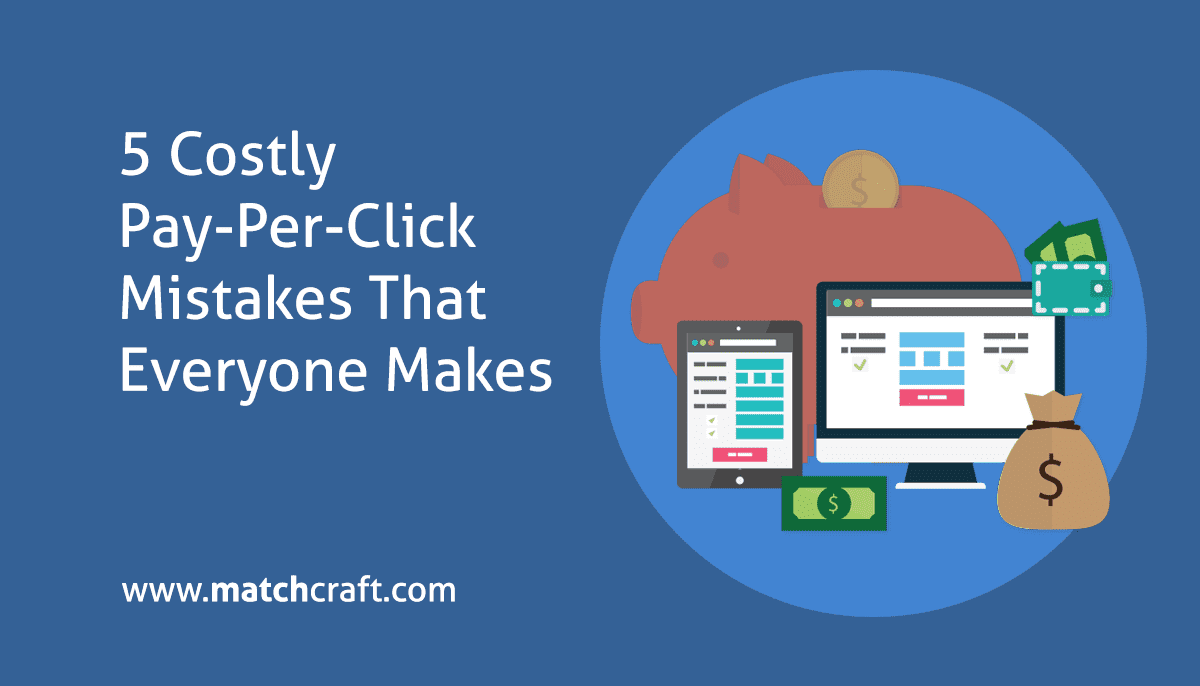We all want to draw more visitors to our websites, but unfortunately, it’s not as easy as a “build it and they will come” setup. You need to entice visitors to your website through a combination of compelling content, social outreach and SEO.
Investing in paid search strategies like pay per click (PPC) can expedite the process. Sounds easy-peasy, right? Well, it is, and it isn’t.
It’s an investment in your digital marketing efforts. That means time, resources and eyeballs on your program to ensure it’s running smoothly. There’s also a risk you could spend a hefty sum of moolah without converting those prized customers you’re aiming for.
Take heed of these common, costly mistakes. And above all, be patient with yourself as you learn and experiment with paid search.
1. Don’t rely on broad match keyword ads.
Broad match keywords get shown when all, or part, of the keyword you’re bidding on is searched for. But don’t pat yourself on the back just yet. This sounds exciting but consider the consequences. You’ll likely wind up with traffic that is just what the name implies: broad!
Let’s say you’re targeting the phrase “red firetruck toy”. Your ad may show up in the search for phrases like “red toy”, “firetruck toy”, “red firetruck,” “about firetrucks” and more. These may not be the best paths for you to capture converting customers. Instead, having your ads match for exact phrases may be your best bet.
Sure, your traffic will decrease. But every visitor will count.
The lesson: More traffic doesn’t mean you’re receiving the right traffic.
2. Sending visitors to your homepage
A common strategy with PPC is touting your best-selling products and services. We get it—these are your gems! So, you do what feels intuitive: you create an ad, bid on a keyword and send traffic to your website’s homepage.
There’s just one problem here. Now your visitor—who was searching for a specific product—has just landed on your homepage, which may or may not feature that product. Assuming it does not, they must click, click, click away and search through your site to look for that product that they (were) so excited about. That is, if they have the patience to deal with this.
The lesson: Don’t make visitors work for information. Give them everything they can—hold their hand!—and guide them to the exact product or service they’re searching for, from your ad straight to your website.
3. Missing out on negative keywords
Negative keywords stop ads from displaying when certain words are searched for. This is helpful in narrowing your website traffic funnel and maintaining relevancy.
For example, if you were a dentist, you may wish to prevent the word “pediatric” from being associated with your ads if you don’t treat any children at your practice.
The lesson: Adding negative keywords can take time, but you may be surprised at just how much it pays off.
4. Your contact page
If you’re antsy to see your newsletter subscription list grow, you may be sending website traffic to your contact form, an effort to capture precious opt-ins. And this is exciting for you and…not so exciting for visitors.
Think about it – if you were searching online for something and landing on a form (versus a product page where you could purchase exactly what you’re seeking), you wouldn’t necessarily be feeling the warm and fuzzies, would you?
There’s another complication here. You may be running against pay per click guidelines. AdWords, for example, prohibits paid search marketers from requiring visitors to fill out a form in exchange for a freebie.
The lesson: Think twice before sending visitors to your website contact form. Better yet, avoid it all together.
5. Not testing your ad copy.
For those new to pay per click, the idea of testing may seem extravagant. Intimidating, even. But today it’s easier than ever to A/B test your ads (test one version against another) and, frankly, not doing these tests is pretty much inexcusable. It’s too easy, and too important, to get this done. Your ad copy matters.
Here’s the deal: if you’re going to bother to invest in paid search, you might as well do it right.
The right ad copy can lead to significantly more website conversions. Nowadays, nearly all paid search platforms hold your hand through split testing. Do the digging. Watch a video on how to get ‘er done. Read the instructions.
Here are some basic adcopy guidelines:
The lesson: Split testing your ad content is critical to seeing ROI on your pay per click investment.
Do you have a question about pay per click, or paid search marketing in general? The team at MatchCraft is comprised of industry experts.







